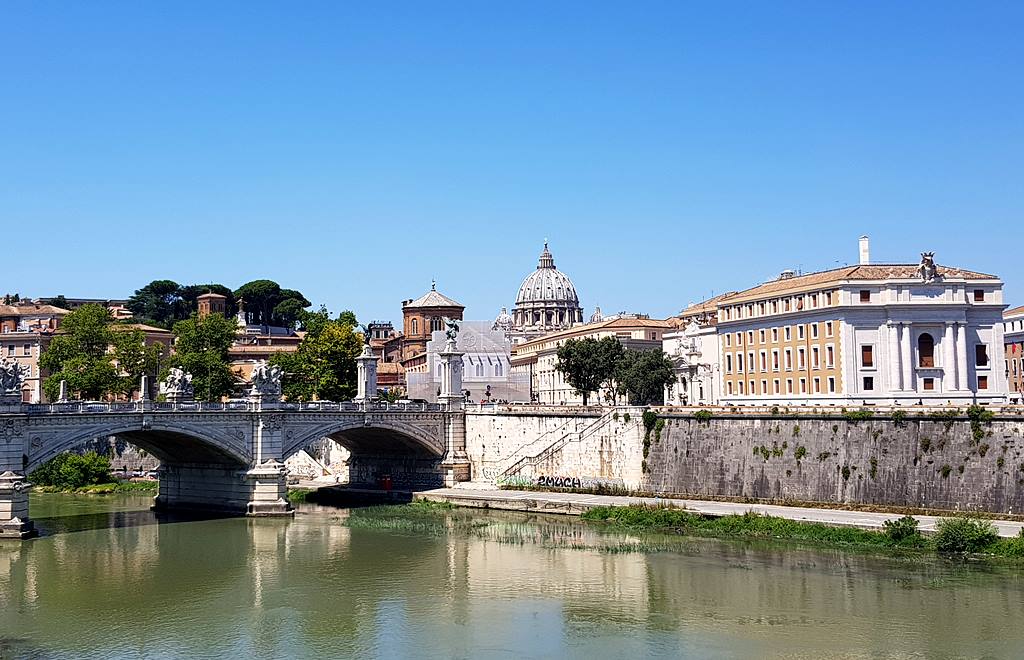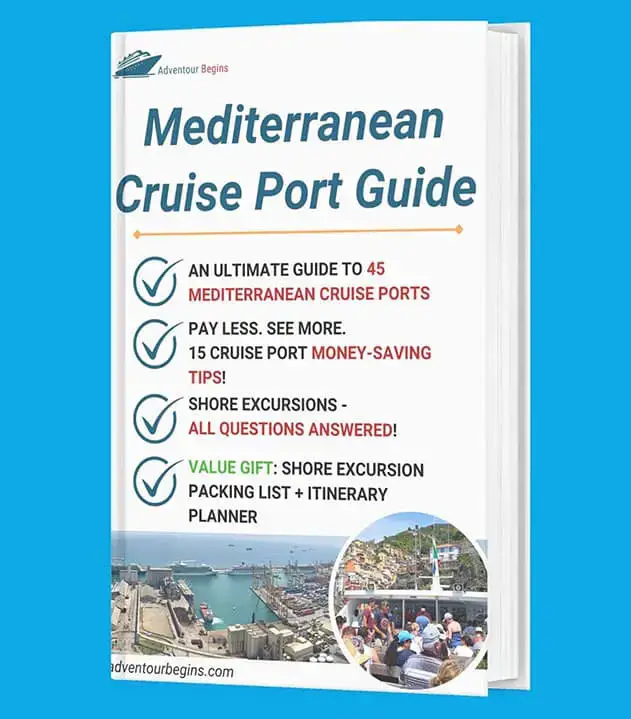Welcome to Civitavecchia cruise port (Rome, Italy)! (Post updated: March 2024)
Civitavecchia port is the largest and busiest Mediterranean seaport and the main gateway to Italy’s capital city of Rome. The coastal town of Civitavecchia sits approximately 80 km/50 miles northwest of the eternal city. The ancient town of Civitavecchia was founded in the 2nd century and visitors who decide to stay in the town can explore its ancient monuments and a lovely seafront promenade. However, most of the cruise passengers decide to visit Rome on their cruise. There are several ways to do so, and in this article, I share with you:
- Civitavecchia cruise port information (Civitavecchia cruise terminal, getting around, how to get to Rome from Civitavecchia port)
- Top 10 things to do in Rome, shore excursions, things to do in Civitavecchia town
Visit also our cruise port guides to La Spezia (Florence/Pisa), Taormina (Messina), Livorno, Cagliari, Naples
Civitavecchia Cruise Port
The port of Civitavecchia is the world’s 13th busiest cruise port and it’s massive – Officially named “Roma Cruise Terminal (aka RCT)”, it consists of 8 cruise terminals and 15 berths that can accommodate the world’s largest cruise liners. Civitavecchia port is also a homeport, meaning that cruises start and end in Civitavecchia.
Civitavecchia Port Link is the shuttle bus that normally runs between the cruise terminals and the train station, from where you can take a train to Rome. The single ticket for this bus costs 6€ one way and the ride takes up to 10 minutes. Alternatively, you can take a free shuttle bus provided by the port authorities to Largo della Pace information point, from where you can walk for 20 minutes or take a local bus to the train station.
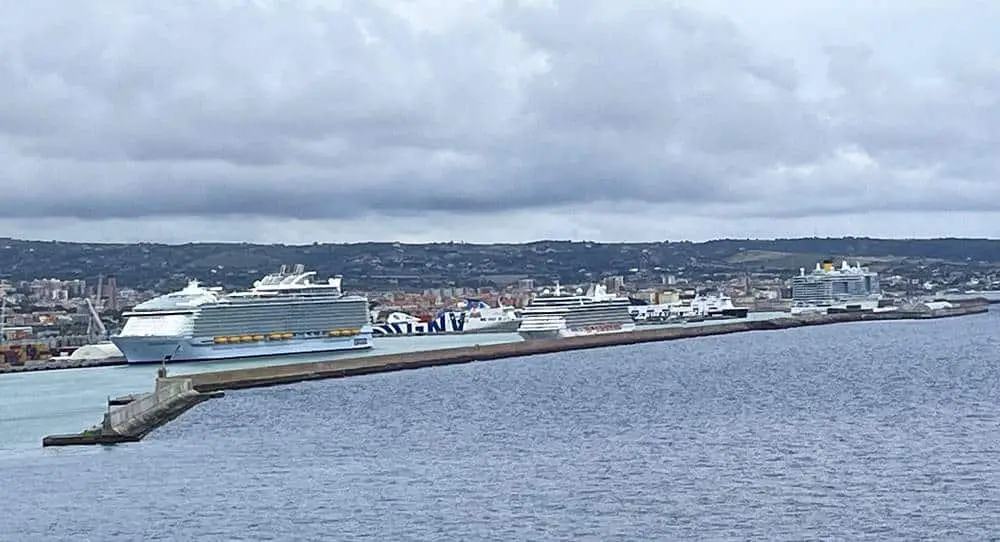
Getting Around Civitavecchia Rome
- The official Civitavecchia port address is Prato del Turco, 00053 Civitavecchia.
- The town of Civitavecchia is located within walking distance of the port. This charming town is known for its 16th-century Fortezza Michelangelo, a beautiful city promenade, a local church and the National Archaeological Museum.
- The currency in Italy is EURO (€). Local currency and major credit cards are widely accepted.
- Civitavecchia train station (Stazione Civitavecchia) is located a 5-minute drive from the port of Civitavecchia. You can use the Civitavecchia Port Link bus to get there, or a free shuttle bus to Largo della Pace information point from where you need to walk for 20 minutes to the train station. At Civitavecchia train station, you can catch a train to Rome, one of the airports, or other cities in Italy.
- Trains run approximately every 30 minutes from Civitavecchia train station to Roma Termini (Rome Central Station) and the ride can last anywhere from 40 minutes to 1 hour 20 minutes, depending on the train. In Rome, you can also get off at San Pietro Station, Trastevere Station, or Ostiense Station, depending on where you want to start your visit. You can purchase the tickets online, or at the ticket office/kiosk at the train station. To check the timetables and fares, check out https://www.trenitalia.com/
- Taxis are also available at the cruise terminal, and the ride to the train station costs around 10€ per person one-way. If you decide to take a taxi to Rome’s city center, expect to pay around 200€ per taxi one-way. You can also book a private transfer or a shore excursion to Rome.
- If you are coming to Civitavecchia from Fiumicino Airport (Leonardo da Vinci International Airport) or Ciampino Airport, the cheapest option is to take a bus to Roma Termini, Rome’s central station, and then take a train to Civitavecchia. Several private companies operate buses from both airports to Roma Termini, and the ticket is typically no more than 7€ per person. Alternatively, you can book a private transfer from the airport to Civitavecchia port, and the cost varies based on the company.
- A convenient way of visiting Rome is by Rome Hop on Hop off bus that includes stops at all major city landmarks. Check out Rome Hop on Hop off bus tours on Viator and Get Your Guide
- In Rome, you can use the Metro Lines A and B to get you to Rome’s major attractions such as Colosseum, Fontana di Trevi, Piazza Navona, and St Peter’s Basilica. The single ticket costs 1.5€ and is valid for 100 minutes. Daily tickets are available at the price of 7€.
- When planning your trip to Rome, keep in mind that crowds in the city are huge and you will probably waste a lot of your time waiting in lines. If you plan to visit the Colosseum or Vatican Museums, I highly recommend you book a guided tour or skip-the-line tickets. The visit to these sights takes at least half a day for each attraction, so keep that in mind as your time in Rome will be limited.
- If you are visiting Rome for the first time and staying only for a few hours, I suggest you either walk and enjoy the external visit of the main attractions, or get around the city center by metro. In case you don’t mind walking, I highly recommend you read my article A Day in Rome: Day Trip from Civitavecchia to Rome where you’ll find a detailed half-day Rome itinerary with maps and explanations.
- Since you will be probably staying in Rome for only one day, booking a guided shore excursion is the safest and most convenient way of exploring the city highlights due to the limited time you’ll have. You can book a guided tour with your cruise line or with a reliable tour operator (usually a cheaper option), however, make sure you double-check the ship’s all onboard time before leaving on a tour. Explore Rome (Civitavecchia) tours and activities
- If you are staying more days in Rome, this article will give you an overview of the best accommodation in Civitavecchia and Rome: 15 Best Hotels near the Port of Civitavecchia (Rome)
- Check out the best hotels in Civitavecchia and Rome
Watch my YouTube Video on Civitavecchia Cruise Port & Best Things to Do in Rome!
10 Must-Do Things In Civitavecchia Cruise Port (Rome)
You’ll find below the top things to do in Rome while on your cruise, as well as the best things to do in Civitavecchia in case to decide to stay in the port.
Before I share the best things to do in Civitavecchia (Rome), I invite you to grab your copy of the “Mediterranean Cruise Port Guide”, the most comprehensive guide to 45 Mediterranean cruise ports (including Civitavecchia), packed with practical information, expert tips & unforgettable experiences! (PDF format/200 pages)
 A Comprehensive Guide to 45 Mediterranean Cruise Ports
Plan your cruise itinerary in less than an hour and maximize your port experience!
A Comprehensive Guide to 45 Mediterranean Cruise Ports
Plan your cruise itinerary in less than an hour and maximize your port experience!
1. St Peter’s Basilica
The Basilica of St Peter is the largest church and one of the most impressive religious structures in the world. It is located in Vatican City and with its immense dimensions and surface area of 22.000 square meters, it can host around 20.000 people. The church is believed to be the burial place of Saint Peter and is home to countless monuments and masterpieces including the works of Bramante, Michelangelo, Maderno, Bernini, and other notable artists.
The entrance to the Basilica is free, although you may face lines and security screening. To get to the Basilica, you need to get off at Stazione San Pietro and then walk for 10 minutes to the square.
Check out St. Peter’s Basilica tours and activities
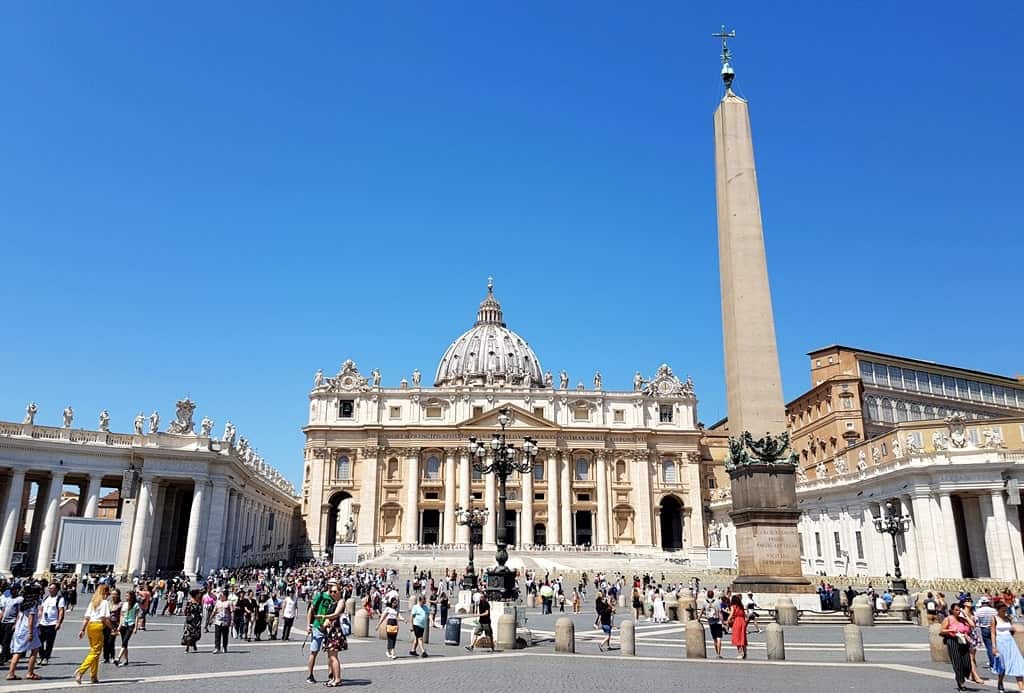
2. Vatican Museums
Vatican Museums are located next to St Peter’s Basilica and you need at least half-day to visit the major artworks and galleries. Because Vatican Museums contain one of the largest collections of artworks in the world, I suggest you make a selection of the main points of interest based on what you want to see. Some of the main places of interest are:
- Sistine Chapel – Goethe said: “Without having seen the Sistine Chapel one can form no appreciable idea of what one man is capable of achieving”. Michelangelo Buonarroti’s masterpiece depicting biblical scenes is a number one must-see in Vatican Museums!
- The Pinacoteca, with 18 rooms housing paintings dating from the Middle Ages to the 19th century, including the works of Giotto, Leonardo da Vinci, Raphael, Perugino and Caravaggio.
- The Pio Clementino Museum – The largest complex inside the Museums that houses the most important Greek and Roman sculpture masterpieces.
- Gregorian Egyptian Museum – This part consists of 9 rooms displaying exhibitions, monuments and artifacts from Ancient Egypt.
- Gallery of Geographical Maps – It is one of the most fascinating rooms in the Museums and an unmissable place for history and geography buffs.
- The Carriage Pavilion – It is located in a separate section of the Museums and displays carriages, cars and sedan chairs used by various popes throughout history.
- The Raphael’s Room – In the 16th century, the rooms were the private apartments of Pope Julius II, who commissioned the frescoes to Raphael.
If you are coming on a cruise and visiting Rome in a day, it is recommended to book a shore excursion with your cruise line to be on the safe side and not risk missing the ship. Alternatively, a cheaper option is to book a tour with a reputable independent tour operator (they usually have a lot of experience with cruise ship passengers so they’ll bring you to your ship on time), or, if you decide to visit on your own, book a skip-the-line ticket to avoid queueing.
Check out the guided tours of Vatican Museums (including the skip-the-line tickets)
3. Castel Sant’Angelo
The imposing fortress is located on the right bank of the Tiber River, a 10-minute walk from St Peter’s Square. The foundations of the castle date back to around 125 B.C. and nowadays it hosts the National Museum of Castel Sant’ Angelo where you can admire a large collection of sculptures, paintings, marble finds, weapons, furniture and various objects.
Check out Castel Sant Angelo’s tours and activities
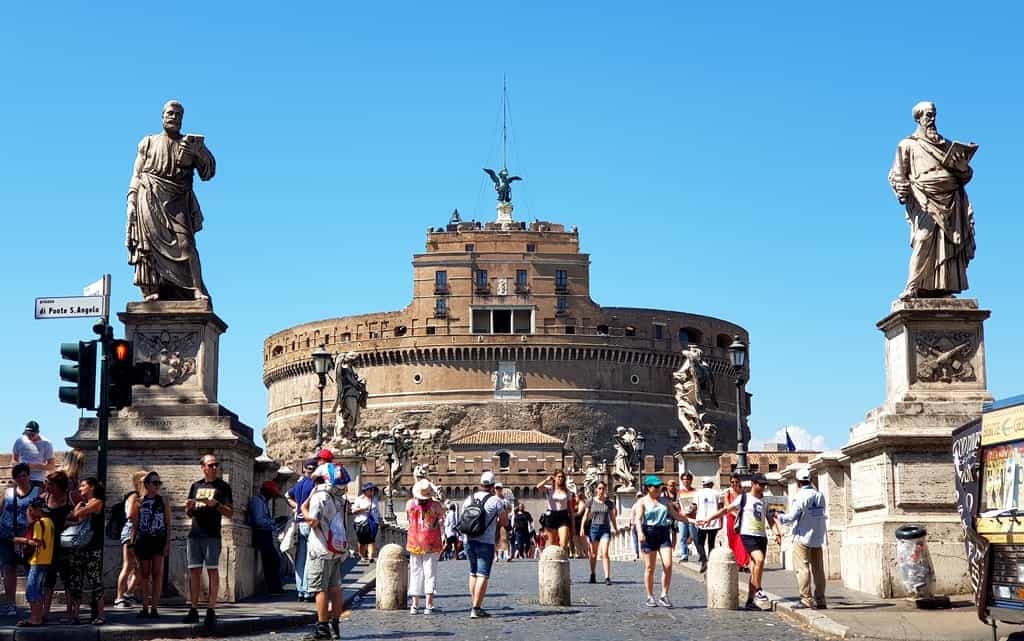
4. Colosseum
The majestic Colosseum is one of the seven wonders of the world and a UNESCO World Heritage Site. Named after its colossal dimensions, the Colosseum is the largest ancient amphitheater in the world dating from 70-80 AD, built under the Roman Emperors Vespasian, and his heir, Titus. The massive amphitheater used to host gladiatorial contests, public spectacles, executions, animal hunts and theatre plays, and could hold on average 70.000 spectators. The Colosseum has been the symbol of Rome for centuries, and nowadays is a must-see attraction!
Cruise lines offer numerous shore excursions to the Colosseum, but you can also visit it on your own. To get to the Colosseum, get off at Roma Termini station and then take the metro line B to the “Colosseo” stop. You will probably face long lines, so it’s recommended to purchase the skip-the-line ticket.
Check out Colosseum tours and tickets
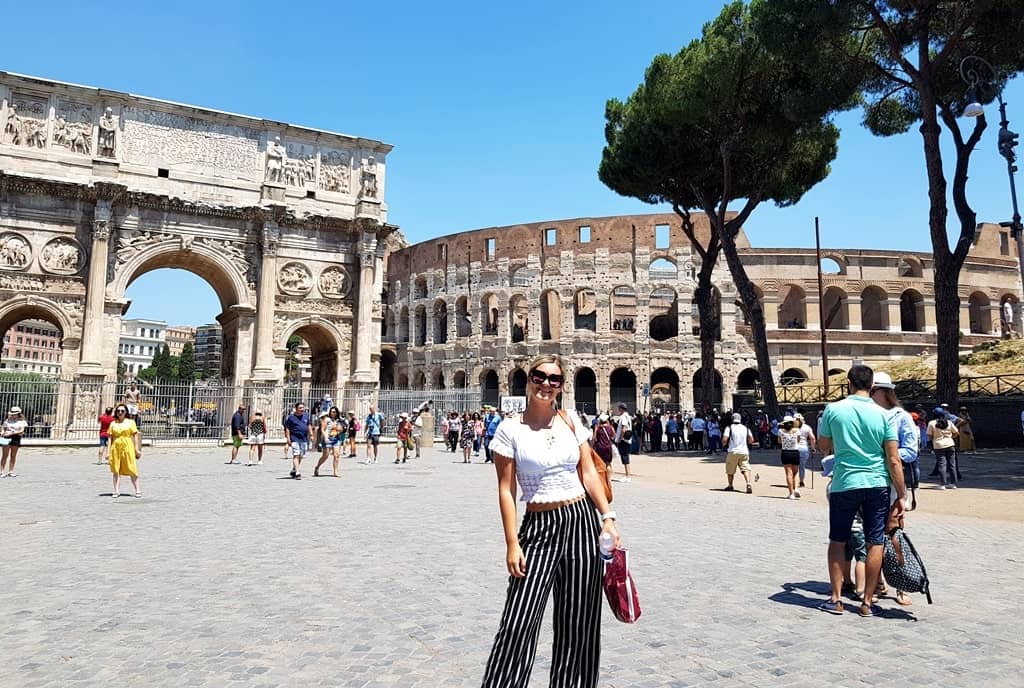
5. Roman Forum
The Roman Forum is one of the most fascinating archeological sites that used to be the center of everyday life and an administrative and commercial hub in Ancient Rome. Today, visitors can see the ruins of antique Temples (Temple of Saturn, Temple of Vespasian and Titus, Temple of Caesar, Temple of Vesta, Temple of Castor and Pollux…), basilicas, squares, Curia Julia (an ancient Senat House), Rostra (the elevated platform where public speakers used to stand), Arch of Septimius Severus, and other ancient structures.
It takes several hours to visit the entire forum, but in case you don’t have time, you can admire it from the street Via dei Fori Imperiali as it has a promenade overlooking the forum. The Roman Forum is located right next to the Colosseum and to get there, get off at Ostiense station and take the metro line B stop “Colosseo”.
Explore the Roman Forum tours and activities
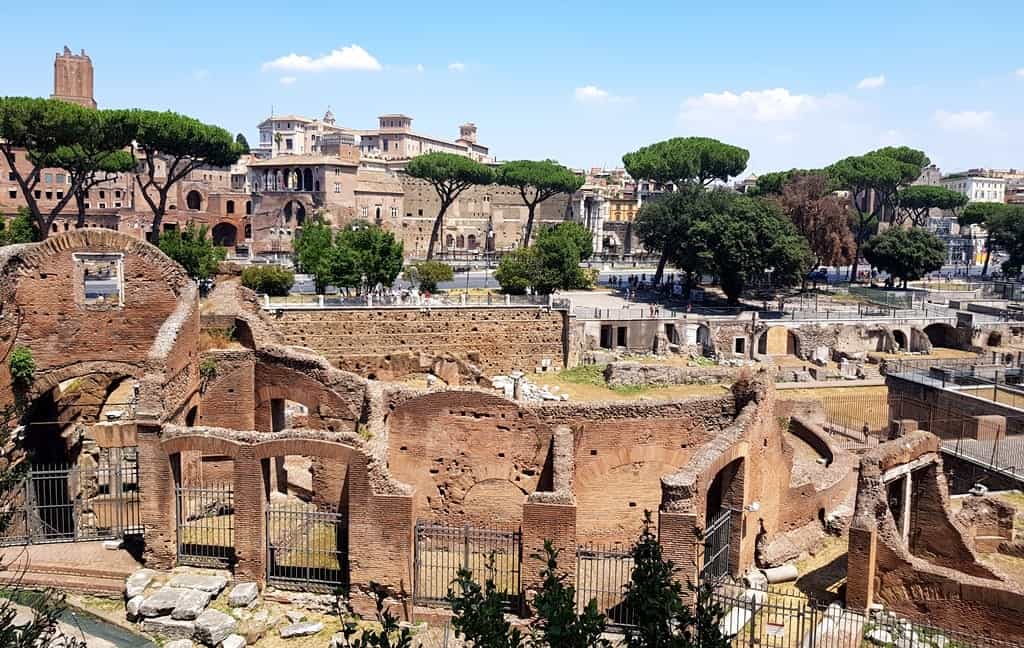
6. Spanish Steps
Piazza di Spagna, with its monumental staircase leading to the church of Trinità dei Monti and Bernini’s baroque fountain Fontana della Barcaccia, is one of the most beautiful squares in Rome. The famous square has always been a popular cultural and tourist hub with a large number of hotels, restaurants, cafes and shopping streets. To get to Spanish Square, get off at Roma Termini station, take the metro line A towards Battistini for 3 stops, and finally get off at the “Spagna” stop.
Check out Spanish Steps tours and activities
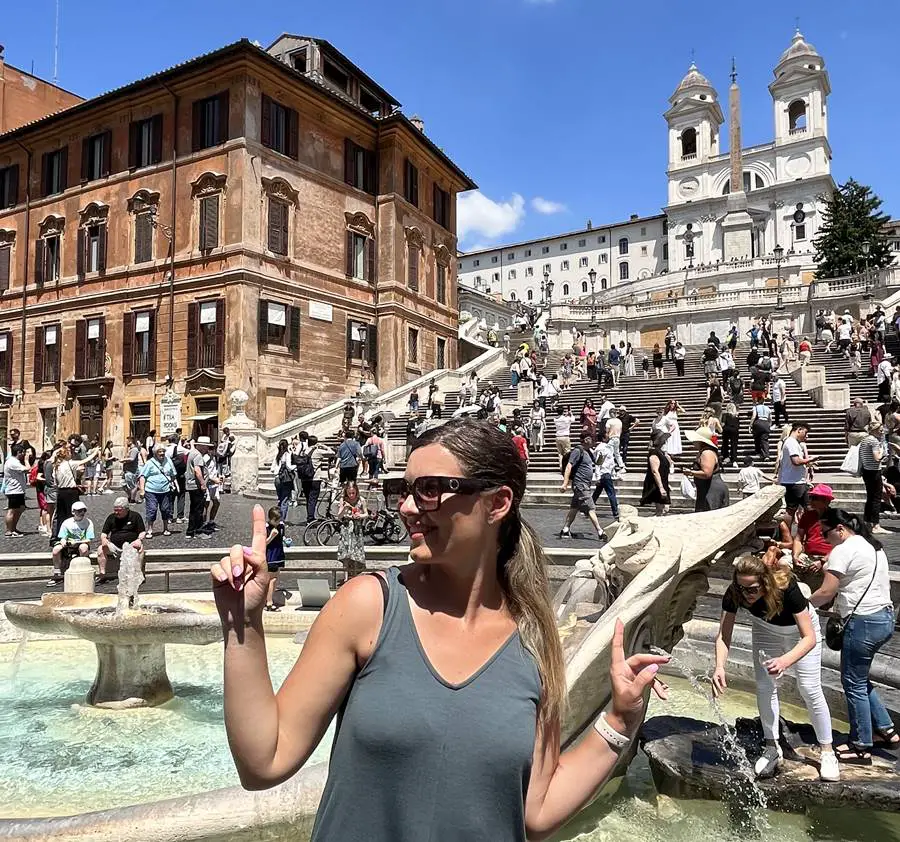
7. Trevi Fountain
Fontana di Trevi is a stunning baroque fountain with rococo elements and is certainly one of the most awe-inspiring fountains in the world. It has gigantic dimensions (26.3 meters high and around 49.15 meters wide) and was designed by Italian architect Nicola Salvi in the 18th century.
The history of the Trevi fountain is connected to Aqua Virgo, an aqueduct dating from 19 B.C. that was used to provide water to the Roman baths and the fountains in central Rome. The Trevi fountain was built at the endpoint of the aqueduct, on the site where three roads intersect, and therefore was named the “Three Roads Fountain” (the “tri viae” in Latin means “three roads”).
Trevi Fountain is located in the historic center and is always packed with people. There is no entrance fee, however, be ready for a lot of crowds. While there, don’t forget to toss a coin into the fountain to ensure you return to Rome! To get to Trevi Fountain, get off at Roma Termini station, get the metro line A towards Battistini and after two stops get off at the “Barberini – Fontana di Trevi” stop.
Explore Trevi Fountain tours and activities
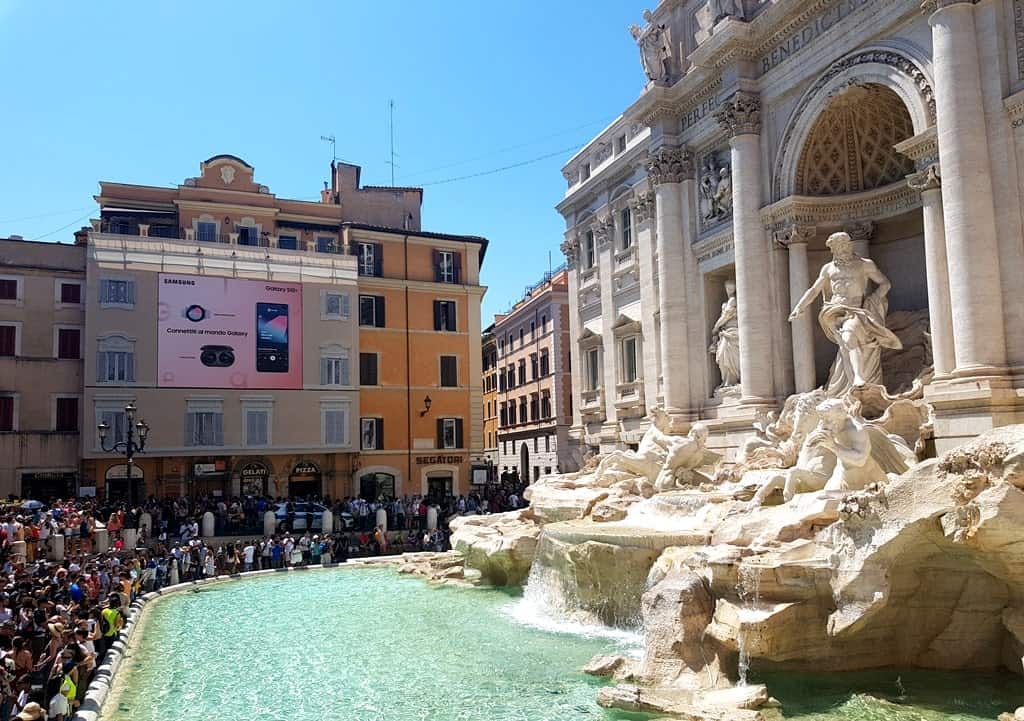
8. Piazza Navona
Originally built as the Stadium of Domitian in the 1st century AD, Piazza Navona is today one of the most visited and most elegant squares in Rome. The square is dominated by three lavish fountains (Fountain of the Four Rivers, Fountain of the Moor and Fountain of Neptun), and shadowed by the immense Sant’Agnese in Agone church, the 17th-century Baroque basilica that contains the skull of St. Agnes in a shrine. Piazza Navona is located within a 10-minute walk from Trevi Fountain.
Explore Piazza Navona tours and activities
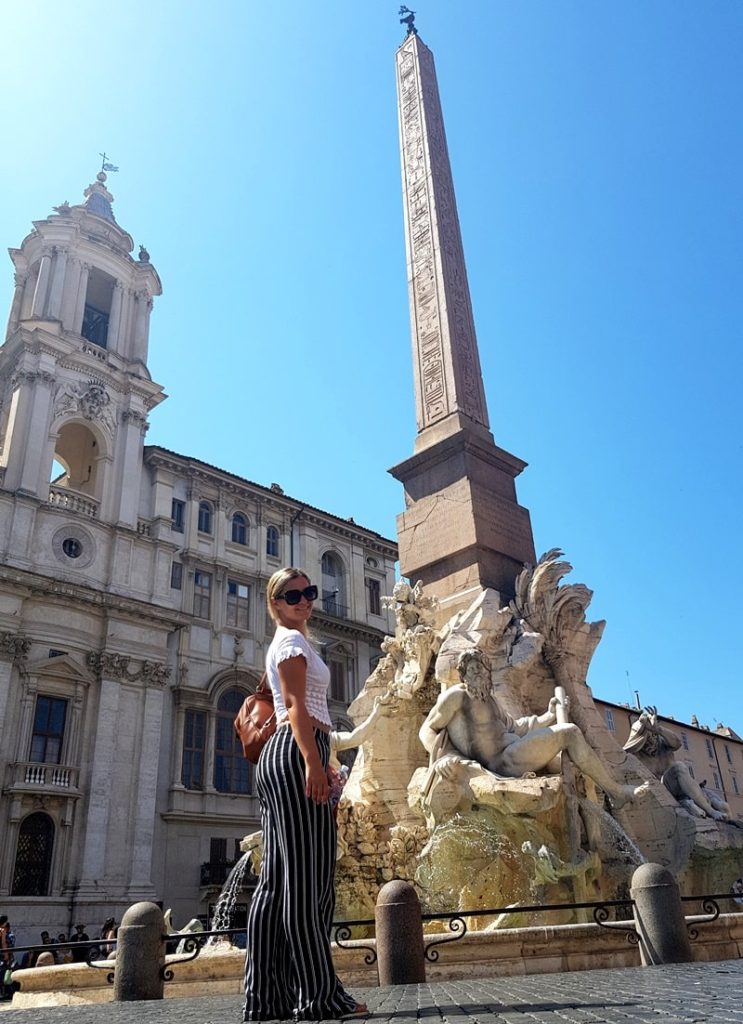
9. Pantheon
A former Roman temple, and nowadays the Catholic Basilica with an imposing dome and massive entry columns, the colossal Pantheon peacefully sits on the tiny Piazza della Rotonda, only 5-10 minutes walking distance from Piazza Navona and Fontana di Trevi.
The iconic temple was completed by Emperor Hadrian in 125 AD, it has a cylindrical shape and features the world’s largest unreinforced dome made entirely of concrete. The central part of the dome has an immense opening that provides natural light to the interior of the temple, which houses tombs of renowned artists and members of the Italian Royal family, including Raphael, Vittorio Emmanuelle II, King Umberto I, and others. The entrance to the Pantheon is free of charge.
Check out Pantheon tours and activities
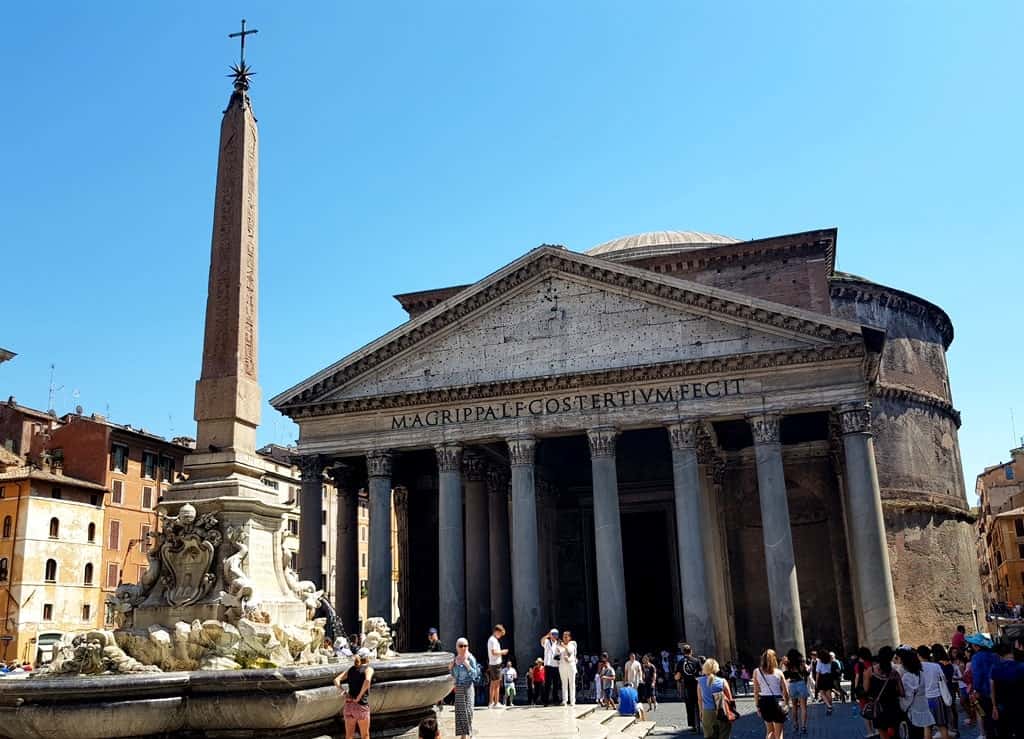
10. Campo de’ Fiori
Not far from Piazza Navona and Pantheon, Campo de Fiori is a popular square hosting one of the most picturesque markets in the city. The square was built in the 15th century on the site of a former flower meadow, thus the name, according to the legend.
Here, you can find fresh fruits, vegetables, meats, fish, and taste some Roman specialties for decent prices in the surrounding bars and eateries. The market is open-air and there is no entrance fee.
Explore Campo de Fiori tours and activities
What to See in Civitavecchia on a Cruise
If you decide not to go to Rome and stay in the town of Civitavecchia, here is a list of things to visit:
- Fortezza Michelangelo (Forte Michelangelo) – The fortress is part of the historic port and you’ll see it by the entrance to the port area. The heavy fortress was built in 1537 to protect the port and was named after Michelangelo who designed the center tower.
- Civitavecchia National Archaeological Museum (Museo Archeologico Nazionale di Civitavecchia) sits right across from Forte Michelangelo and is housed in a 3-level building that used to belong to Pope Clemente XIII, dating from the early 18th century. In the museum, visitors can see exhibitions showcasing artifacts from the Roman and Etruscan times.
- The Cathedral of San Francesco d’Assisi (Cattedrale di S. Francesco d’Assisi) – A beautiful elegant cathedral was built in the 17th century in the Neoclassical-Baroque architectural style. It’s located a stone’s throw from the Archeological museum and Forte Michelangelo.
- Taurine Baths (Terme Taurine or Trajan) – The archeological site of the Taurine Baths is located on top of the hill approximately 5 km/3 miles from Civitavecchia town center. Known also as the Baths of Trajan, after the Roman emperor who founded the city, the baths are one of the most important thermal complexes of the Roman Age in the entire south Etrurian area.
- Civitavecchia Beach (Spiaggia il pirgo) – A small pebbly beach is located right opposite the railway station and is backed by a colorful promenade.
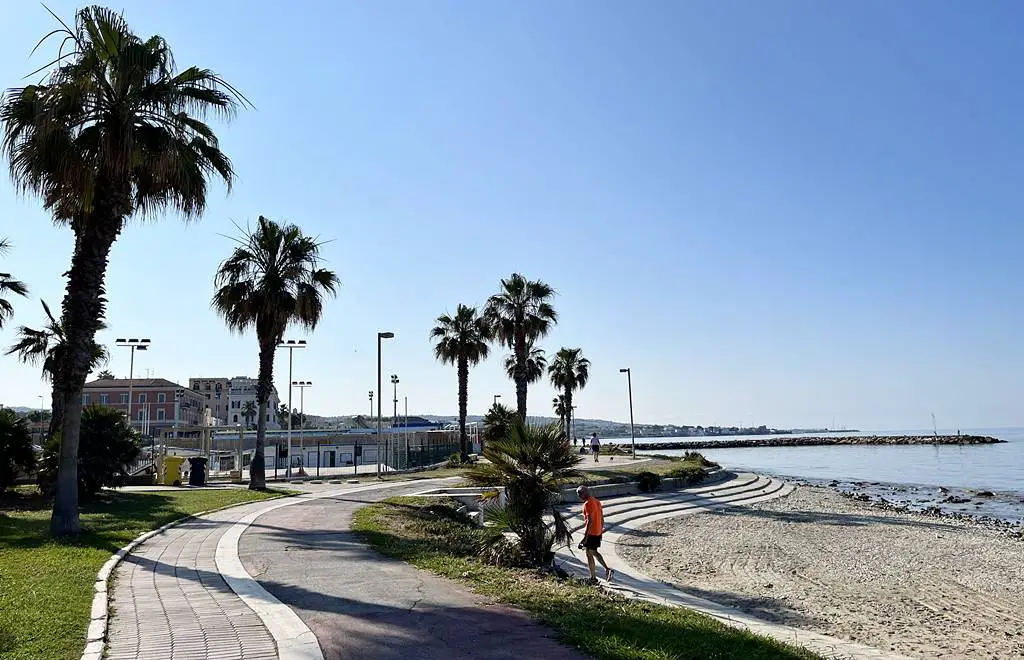
Visit also our cruise port guides to Santorini, Athens, Ajaccio, Marseille, Kotor, Palma de Mallorca, Barcelona
You may also like our cruise port guides to the Mediterranean, Caribbean, Western Europe, Baltic & Scandinavia, USA & Canada, Australia & New Zealand
Don’t miss out on the opportunity to enhance your Mediterranean cruise experience with our “Mediterranean Cruise Port Guide“- your ultimate companion to discovering the region’s hidden treasures and creating unforgettable memories; click below to purchase your copy today and embark on the voyage of a lifetime!

Ultimate Guide to Mediterranean Cruise Ports
Plan your Cruise Itinerary in Less than an Hour and Maximize Your Port
Experience!
This article may contain affiliate / compensated links. For full information, please see my disclaimer here.


